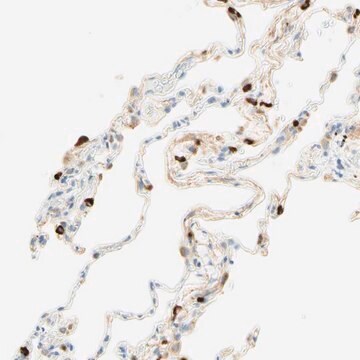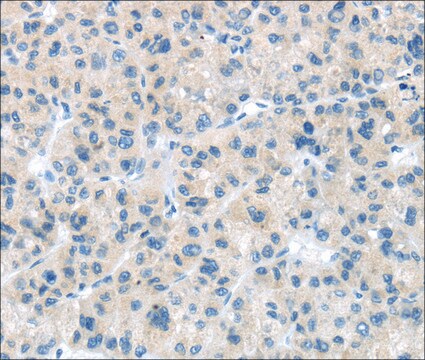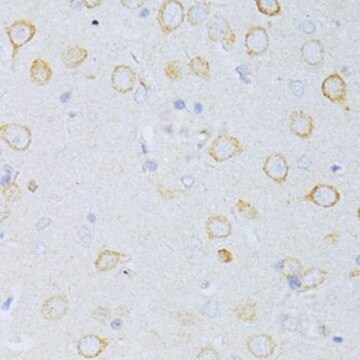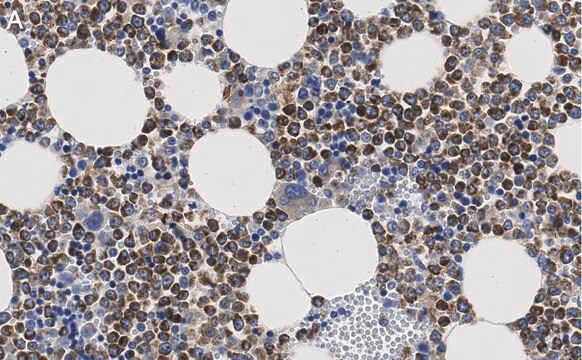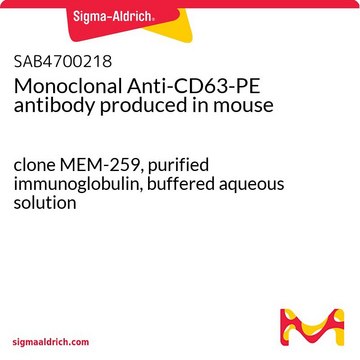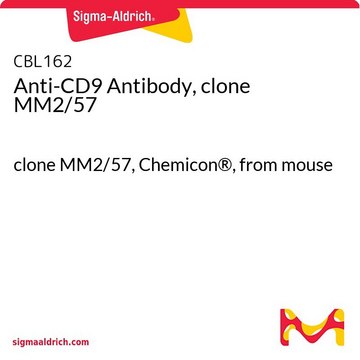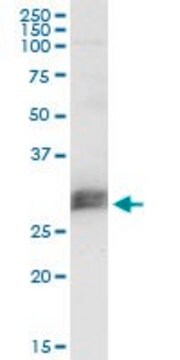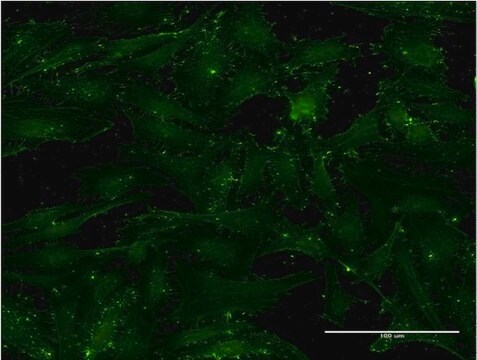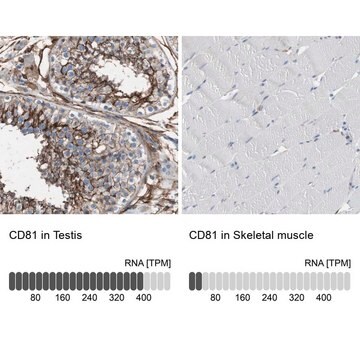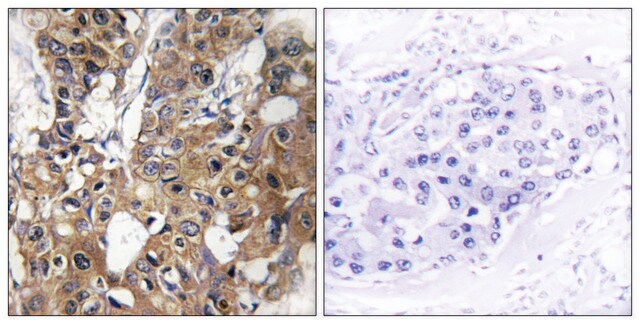SAB4700215
Monoclonal Anti-CD63 antibody produced in mouse
clone MEM-259, purified immunoglobulin, buffered aqueous solution
Zaloguj sięWyświetlanie cen organizacyjnych i kontraktowych
About This Item
Kod UNSPSC:
12352203
NACRES:
NA.41
Polecane produkty
pochodzenie biologiczne
mouse
Poziom jakości
białko sprzężone
unconjugated
forma przeciwciała
purified immunoglobulin
rodzaj przeciwciała
primary antibodies
klon
MEM-259, monoclonal
Formularz
buffered aqueous solution
reaktywność gatunkowa
human
stężenie
1 mg/mL
metody
flow cytometry: suitable
izotyp
IgG1
numer dostępu NCBI
numer dostępu UniProt
Warunki transportu
wet ice
temp. przechowywania
2-8°C
docelowa modyfikacja potranslacyjna
unmodified
informacje o genach
human ... CD63(967)
Opis ogólny
Cluster of differentiation 63 (CD63), also known as melanoma 1 antigen, is encoded by the gene mapped to human chromosome 12q13.2. The encoded protein belongs to the transmembrane 4 superfamily (TM4SF). CD63 is an integral membrane glycoprotein expressed in late endosomes and lysosomes and is also present in the platelet dense granule membrane.
The antibody MEM-259 reacts with CD63 (LAMP-3), a 40-60 kDa tetraspan glycoprotein expressed by granulocytes, platelets, T cells, monocytes/macrophages and endothelial cells. Cell surface exposition of CD63 is usually activation-dependent.
Immunogen
HPB-ALL T cell line
Zastosowanie
Monoclonal Anti-CD63 antibody produced in mouse has been used in flow cytometry and confocal imaging.
The reagent is designed for Flow Cytometry analysis. Suggested working dilution for Flow Cytometry is 2 μg/mL of sample. Indicated dilution is recommended starting point for use of this product. Working concentrations should be determined by the investigator.
Działania biochem./fizjol.
Cluster of differentiation 63 (CD63) is one of the platelet activation marker, which plays a vital role in platelet aggregation, adhesion to collagen, uptake of oxidized low-density lipoprotein (LDL) in vitro and regulation of angiogenesis. Inadequate expression of CD63 results in the autosomal recessive inherited disorder, Hermansky-Pudlak syndrome. CD63 is associated with various cellular functions, such as cellular adhesion, cell differentiation, migration, carcinogenesis and tumor progression. CD63 is highly expressed in the initial stage of Merkel cell carcinoma and decreased in later stages; therefore, CD63 is considered to be a potential prognostic factor for this malignancy.
Cechy i korzyści
Evaluate our antibodies with complete peace of mind. If the antibody does not perform in your application, we will issue a full credit or replacement antibody. Learn more.
Postać fizyczna
Solution in phosphate buffered saline, pH 7.4, with 15 mM sodium azide.
Oświadczenie o zrzeczeniu się odpowiedzialności
Unless otherwise stated in our catalog or other company documentation accompanying the product(s), our products are intended for research use only and are not to be used for any other purpose, which includes but is not limited to, unauthorized commercial uses, in vitro diagnostic uses, ex vivo or in vivo therapeutic uses or any type of consumption or application to humans or animals.
Ta strona może zawierać tekst przetłumaczony maszynowo.
Nie możesz znaleźć właściwego produktu?
Wypróbuj nasz Narzędzie selektora produktów.
Kod klasy składowania
10 - Combustible liquids
Temperatura zapłonu (°F)
Not applicable
Temperatura zapłonu (°C)
Not applicable
Wybierz jedną z najnowszych wersji:
Masz już ten produkt?
Dokumenty związane z niedawno zakupionymi produktami zostały zamieszczone w Bibliotece dokumentów.
Klienci oglądali również te produkty
Detection of phosphatidylserine-positive exosomes as a diagnostic marker for ovarian malignancies: a proof of concept study
Lea J, et.al.
Oncotarget, 8, 14395-14407 (2017)
Jayanthi Lea et al.
Oncotarget, 8(9), 14395-14407 (2017-01-26)
There are no suitable screening modalities for ovarian carcinomas (OC) and repeated imaging and CA-125 levels are often needed to triage equivocal ovarian masses. Definitive diagnosis of malignancy, however, can only be established by histologic confirmation. Thus, the ability to
Gene expression signature associated with BRAF mutations in human primary cutaneous melanomas
Kannengiesser C
Molecular Oncology, 1, 425-430 (2008)
Tra-Ly Nguyen et al.
Cancer research, 78(18), 5384-5397 (2018-07-29)
The mTOR is a central regulator of cell growth and is highly activated in cancer cells to allow rapid tumor growth. The use of mTOR inhibitors as anticancer therapy has been approved for some types of tumors, albeit with modest
Improved metabolic control decreases platelet activation markers in patients with type-2 diabetes.
Eibl N
European Journal of Clinical Investigation, 34, 205-209 (2004)
Nasz zespół naukowców ma doświadczenie we wszystkich obszarach badań, w tym w naukach przyrodniczych, materiałoznawstwie, syntezie chemicznej, chromatografii, analityce i wielu innych dziedzinach.
Skontaktuj się z zespołem ds. pomocy technicznej